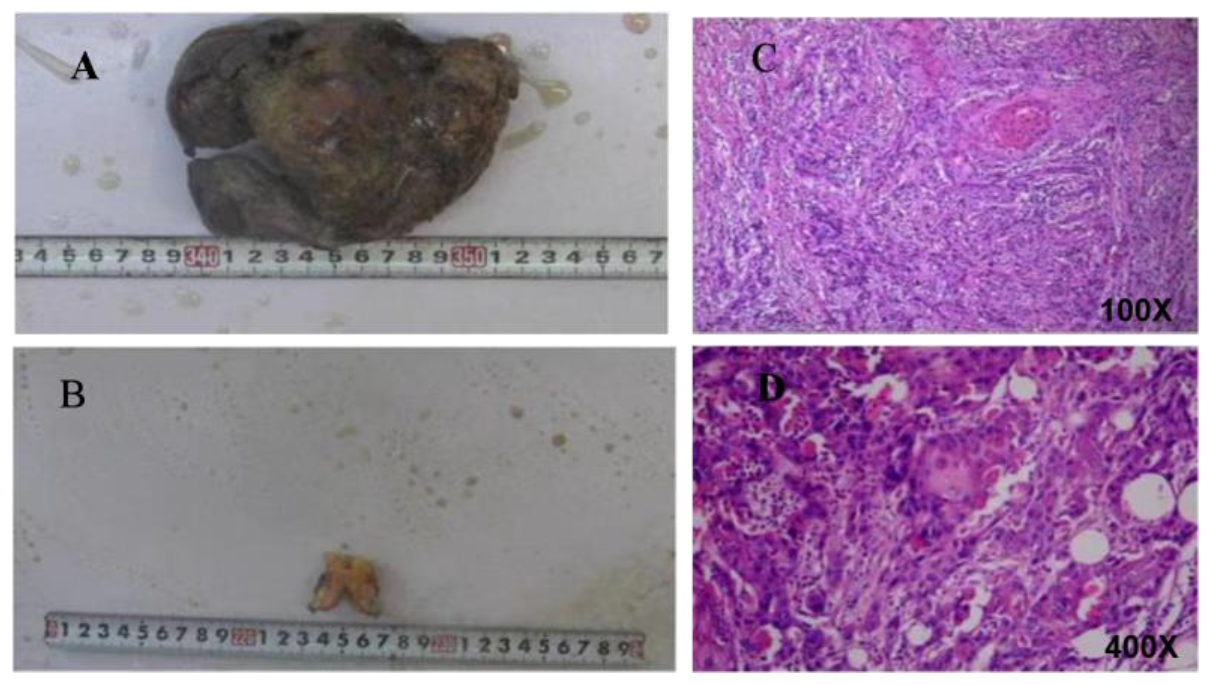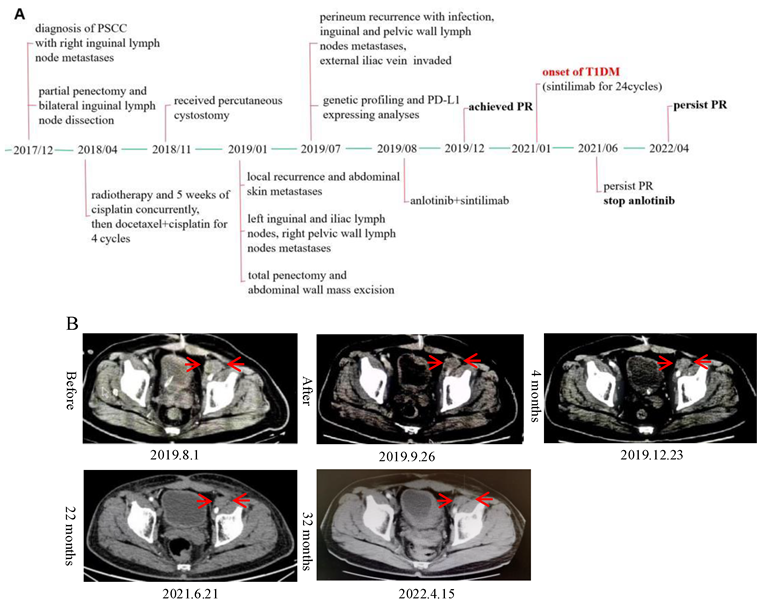Sintilimab-Induced Diabetic Ketoacidosis in a Patient with Radiation and Multichemorefractory Penile Cancer: A Case Report and Literature Review
Abstract
:1. Background
2. Case Report
3. Discussion
4. Conclusions
Author Contributions
Funding
Institutional Review Board Statement
Informed Consent Statement
Data Availability Statement
Conflicts of Interest
References
- Yi, M.; Zheng, X.; Niu, M.; Zhu, S.; Ge, H.; Wu, K. Combination strategies with PD-1/PD-L1 blockade: Current advances and future directions. Mol. Cancer 2022, 21, 28. [Google Scholar] [CrossRef] [PubMed]
- Barone, B.; Calogero, A.; Scafuri, L.; Ferro, M.; Lucarelli, G.; Di Zazzo, E.; Sicignano, E.; Falcone, A.; Romano, L.; De Luca, L.; et al. Immune Checkpoint Inhibitors as a Neoadjuvant/Adjuvant Treatment of Muscle-Invasive Bladder Cancer: A Systematic Review. Cancers 2022, 14, 2545. [Google Scholar] [CrossRef] [PubMed]
- Ribas, A. Releasing the Brakes on Cancer Immunotherapy. N. Engl. J. Med. 2015, 373, 1490–1492. [Google Scholar] [CrossRef]
- Postow, M.A.; Sidlow, R.; Hellmann, M.D. Immune-Related Adverse Events Associated with Immune Checkpoint Blockade. N. Engl. J. Med. 2018, 378, 158–168. [Google Scholar] [CrossRef] [PubMed]
- Paschou, S.A.; Stefanaki, K.; Psaltopoulou, T.; Liontos, M.; Koutsoukos, K.; Zagouri, F.; Lambrinoudaki, I.; Dimopoulos, M.-A. How we treat endocrine complications of immune checkpoint inhibitors. ESMO Open 2021, 6, 100011. [Google Scholar] [CrossRef] [PubMed]
- Liu, X.; Yi, Y. Recent updates on Sintilimab in solid tumor immunotherapy. Biomark. Res. 2020, 8, 69. [Google Scholar] [CrossRef]
- Cocks, M.; Taheri, D.; Ball, M.W.; Bezerra, S.M.; Del Carmen Rodriguez, M.; Ricardo, B.F.P.; Bivalacqua, T.J.; Sharma, R.B.; Meeker, A.; Chaux, A.; et al. Share Immune-checkpoint status in penile squamous cell carcinoma: A North American cohort. Hum. Pathol. 2017, 59, 55–61. [Google Scholar] [CrossRef]
- Stecca, C.E.; Alt, M.; Jiang, D.M.; Chung, P.; Crook, J.M.; Kulkarni, G.S.; Sridhar, S.S. Recent Advances in the Management of Penile Cancer: A Contemporary Review of the Literature. Oncol. Ther. 2021, 9, 21–39. [Google Scholar] [CrossRef]
- Stoehr, R.; Wendler, O.; Giedl, J.; Gaisa, N.T.; Richter, G.; Campean, V.; Burger, M.; Wullich, B.; Bertz, S.; Hartmann, A. No Evidence of Microsatellite Instability and Loss of Mismatch-Repair-Protein Expression in Squamous Cell Carcinoma of the Penis. Pathobiology 2019, 86, 145–151. [Google Scholar] [CrossRef]
- Yang, Y.; Liu, J.; Yang, K.; Ma, Y.; Fu, S.; Tang, X.; Wang, Y.; Zhou, L. Endocrine Adverse Events Caused by Different Types and Different Doses of Immune Checkpoint Inhibitors in the Treatment of Solid Tumors: A Meta-Analysis and Systematic Review. J. Clin. Pharmacol. 2021, 61, 282–297. [Google Scholar] [CrossRef]
- Baweja, A.; Mar, N. Metastatic penile squamous cell carcinoma with dramatic response to combined checkpoint blockade with ipilimumab and nivolumab. J. Oncol. Pharm. Pract. 2021, 27, 212–215. [Google Scholar] [CrossRef] [PubMed]
- Trafalis, D.T.; Alifieris, C.E.; Kalantzis, A.; Verigos, K.E.; Vergadis, C.; Sauvage, S. Evidence for Efficacy of Treatment With the Anti-PD-1 Mab Nivolumab in Radiation and Multichemorefractory Advanced Penile Squamous Cell Carcinoma. J. Immunother. 2018, 41, 300–305. [Google Scholar] [CrossRef] [PubMed]
- Hui, G.; Ghafouri, S.N.; Shen, J.; Liu, S.; Drakaki, A. Treating Penile Cancer in the Immunotherapy and Targeted Therapy Era. Case Rep. Oncol. Med. 2019, 2019, 8349793. [Google Scholar] [CrossRef] [PubMed] [Green Version]
- Chahoud, J.; Skelton, W.P., IV; Spiess, P.E.; Walko, C.; Dhillon, J.; Gage, K.L.; Johnstone, P.A.S.; Jain, R.K. Case Report: Two Cases of Chemotherapy Refractory Metastatic Penile Squamous Cell Carcinoma With Extreme Durable Response to Pembrolizumab. Front. Oncol. 2020, 10, 615298. [Google Scholar] [CrossRef] [PubMed]
- Hahn, A.W.; Chahoud, J.; Campbell, M.T.; Karp, D.D.; Wang, J.; Stephen, B.; Tu, S.-M.; Pettaway, C.A.; Naing, A. Pembrolizumab for advanced penile cancer: A case series from a phase II basket trial. Investig. New Drugs 2021, 39, 1405–1410. [Google Scholar] [CrossRef]
- Denis, C.; Sakalihasan, S.; Frères, P.; Withofs, N.; Sautois, B. Cemiplimab for Cisplatin Resistant Metastatic Penile Cancer. Case Rep. Oncol. 2021, 14, 972–976. [Google Scholar] [CrossRef]
- Su, X.; Zhang, J.; Fu, C.; Xiao, M.; Wang, C. Recurrent Metastatic Penile Cancer Patient with Positive PD-L1 Expression Obtained Significant Benefit from Immunotherapy: A Case Report and Literature Review. OncoTargets Ther. 2020, 13, 3319–3324. [Google Scholar] [CrossRef] [Green Version]
- Hu, L.; Shan, X.; Han, D.; Guo, Z.; Wang, H.; Xiao, Z. Multimodal Treatment Combining Salvage Surgery-Assisted Chemotherapy and Checkpoints Blockade Immunotherapy Achieves Complete Remission on a Recurrent Penile Cancer Patient: A Case Report. OncoTargets Ther. 2021, 14, 4891–4896. [Google Scholar] [CrossRef]
- Li, N.; Xu, T.; Zhou, Z.; Li, P.; Jia, G.; Li, X. Immunotherapy Combined With Chemotherapy for Postoperative Recurrent Penile Squamous Cell Carcinoma: A Case Report and Literature Review. Front. Oncol. 2022, 12, 837547. [Google Scholar] [CrossRef]
- Mei, X.; Zhao, Y.; Zhang, Y.; Liao, J.; Jiang, C.; Qian, H.; Du, Y. Efficacy and Biomarker Exploration of Sintilimab Combined With Chemotherapy in the Treatment of Advanced Penile Squamous Cell Carcinoma—A Report of Two Cases. Front. Oncol. 2022, 12, 823459. [Google Scholar] [CrossRef]
- Clotman, K.; Janssens, K.; Specenier, P.; Weets, I.; De Block, C.E.M. Programmed Cell Death-1 Inhibitor–Induced Type 1 Diabetes Mellitus. J. Clin. Endocrinol. Metab. 2018, 103, 3144–3154. [Google Scholar] [CrossRef] [PubMed] [Green Version]
- Lopes, A.R.; Russo, A.; Li, A.Y.; McCusker, M.G.; Kroopnick, J.M.; Scilla, K.; Mehra, R.; Rolfo, C. Development of autoimmune diabetes with severe diabetic ketoacidosis and immune-related thyroiditis secondary to durvalumab: A case report. Transl. Lung Cancer Res. 2020, 9, 2149–2156. [Google Scholar] [CrossRef] [PubMed]
- Muniz, T.P.; Araujo, D.V.; Savage, K.J.; Cheng, T.; Saha, M.; Song, X.; Gill, S.; Monzon, J.G.; Grenier, D.; Genta, S.; et al. CANDIED: A Pan-Canadian Cohort of Immune Checkpoint Inhibitor-Induced Insulin-Dependent Diabetes Mellitus. Cancers 2021, 14, 89. [Google Scholar] [CrossRef] [PubMed]
- de Filette, J.M.K.; Pen, J.J.; Decoster, L.; Vissers, T.; Bravenboer, B.; Van der Auwera, B.J.; Gorus, F.K.; Roep, B.O.; Aspeslagh, S.; Neyns, B.; et al. Immune checkpoint inhibitors and type 1 diabetes mellitus: A case report and systematic review. Eur. J. Endocrinol. 2019, 181, 363–374. [Google Scholar] [CrossRef] [Green Version]
- Kawabata, Y.; Ikegami, H.; Awata, T.; Imagawa, A.; Maruyama, T.; Kawasaki, E.; Tanaka, S.; Shimada, A.; Osawa, H.; Kobayashi, T.; et al. Committee on Type 1 Diabetes, Japan Diabetes Society. Differential association of HLA with three subtypes of type 1 diabetes: Fulminant, slowly progressive and acute-onset. Diabetologia 2009, 52, 2513–2521. [Google Scholar] [CrossRef]
- Pociot, F.; Lernmark, Å. Genetic risk factors for type 1 diabetes. Lancet 2016, 387, 2331–2339. [Google Scholar] [CrossRef]
- Zhang, R.; Cai, X.-L.; Liu, L.; Han, X.-Y.; Ji, L.-N. Type 1 diabetes induced by immune checkpoint inhibitors. Chin. Med. J. 2020, 133, 2595–2598. [Google Scholar] [CrossRef]
- Akturk, H.K.; Kahramangil, D.; Sarwal, A.; Hoffecker, L.; Murad, M.H.; Michels, A.W. Immune checkpoint inhibitor-induced Type 1 diabetes: A systematic review and meta-analysis. Diabet. Med. 2019, 36, 1075–1081. [Google Scholar] [CrossRef]


| Author | Age | PD-L1 Status | MSI Status | TMB | Outcome |
|---|---|---|---|---|---|
| Baweja et al. [11] (2021) | 47 | TPS: 90% | MSI-high | High (24 Muts/Mb) | 12-month follow up, PR |
| Trafalis et al. [12] (2018) | 47 | TPS: ≈10% | Stable | High | 6-month follow up, PR |
| Hui et al. [13] (2019) | 64 | UK | UK | UK | 6-month follow up, Stable |
| Hui et al. [13] (2019) | 79 | UK | UK | UK | 24-month follow up, CR |
| Chahoud et al. [14] (2020) | 64 | UK | UK | High (14 Muts/Mb) | 38-month follow up, CR |
| Chahoud et al. [14] (2020) | 85 | CPS: 130 | Stable | Low (3 Muts/Mb) | 18-month follow up, PR |
| Hahn et al. [15] (2021) | 76 | TPS: 10% | MSI-high | UK | 38.7-month follow up, PR |
| Hahn et al. [15] (2021) | 72 | TPS: 80% | Stable | UK | 8.3-month follow up, PD |
| Hahn et al. [15] (2021) | 66 | TPS: 1% | Stable | UK | 3.8-month follow up, PD, |
| Denis et al. [16] (2021) | 75 | TPS: >95% | UK | UK | 15.1-month follow up, CR |
| Su et al. [17] (2020) | 46 | TPS: ≥10% | Stable | High (8.87 Muts/Mb) | 10.5-month follow up, CR |
| Hu et al. [18] (2021) | 49 | TPS: 20~30% | Stable | Low (2.25 Muts/Mb) | 19-month follow up, CR |
| Li et al. [19] (2022) | 76 | TPS: ≈10% | UK | UK | 5-month follow up, CR |
| Mei et al. [20] (2022) | 63 | TPS: 50~60% | Stable | High (17.95 Muts/Mb) | 28-month follow up, PR |
| Mei et al. [20] (2022) | 39 | TPS: <1% | Stable | Low (0 Muts/Mb) | 24-month follow up, CR |
| Present case (2022) | 52 | TPS: 90% | Stable | High (14.40 Muts/Mb) | 32-month follow up, PR |
Publisher’s Note: MDPI stays neutral with regard to jurisdictional claims in published maps and institutional affiliations. |
© 2022 by the authors. Licensee MDPI, Basel, Switzerland. This article is an open access article distributed under the terms and conditions of the Creative Commons Attribution (CC BY) license (https://creativecommons.org/licenses/by/4.0/).
Share and Cite
Lv, C.; Wu, C.; Zhang, Y.; Li, W.; Wang, X.; Liang, L. Sintilimab-Induced Diabetic Ketoacidosis in a Patient with Radiation and Multichemorefractory Penile Cancer: A Case Report and Literature Review. Curr. Oncol. 2022, 29, 7987-7993. https://doi.org/10.3390/curroncol29110632
Lv C, Wu C, Zhang Y, Li W, Wang X, Liang L. Sintilimab-Induced Diabetic Ketoacidosis in a Patient with Radiation and Multichemorefractory Penile Cancer: A Case Report and Literature Review. Current Oncology. 2022; 29(11):7987-7993. https://doi.org/10.3390/curroncol29110632
Chicago/Turabian StyleLv, Chuan, Can Wu, Yan Zhang, Wendong Li, Xuesong Wang, and Li Liang. 2022. "Sintilimab-Induced Diabetic Ketoacidosis in a Patient with Radiation and Multichemorefractory Penile Cancer: A Case Report and Literature Review" Current Oncology 29, no. 11: 7987-7993. https://doi.org/10.3390/curroncol29110632
APA StyleLv, C., Wu, C., Zhang, Y., Li, W., Wang, X., & Liang, L. (2022). Sintilimab-Induced Diabetic Ketoacidosis in a Patient with Radiation and Multichemorefractory Penile Cancer: A Case Report and Literature Review. Current Oncology, 29(11), 7987-7993. https://doi.org/10.3390/curroncol29110632




